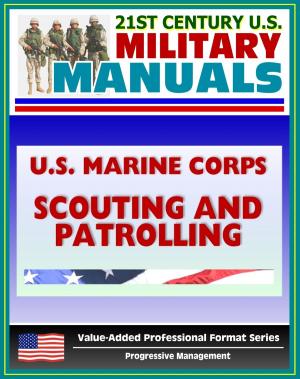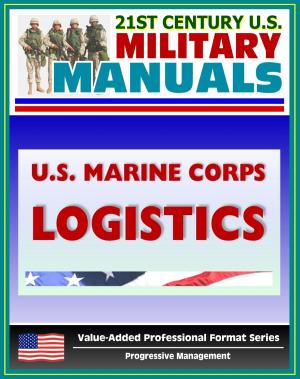The Path to War: U.S. Marine Corps Operations in Southeast Asia 1961 to 1965 - Response to Communist Aggression, Laos, Thailand, Vietnam, Ho Chi Minh, Mao Tse-tung, Advisors to Major Forces
Nonfiction, History, Military, Vietnam War, Asian, United States| Author: | Progressive Management | ISBN: | 9781310430121 |
| Publisher: | Progressive Management | Publication: | February 24, 2015 |
| Imprint: | Smashwords Edition | Language: | English |
| Author: | Progressive Management |
| ISBN: | 9781310430121 |
| Publisher: | Progressive Management |
| Publication: | February 24, 2015 |
| Imprint: | Smashwords Edition |
| Language: | English |
This narrative chronicles the activities of the U.S. Marine Corps in Southeast Asia from January 1961 to March 1965. The period witnesses increasing Marine Corps involvement in the region as our nation's leaders responded to Communist aggression and sought to protect the United States' national interests. Individual Marines saw duty as early as 1954 when a Marine lieutenant colonel was assigned to the U.S. Military Assistance Advisory Group (MAAG) in Saigon, South Vietnam. The first involvement of a Marine Corps operational unit came in March 1961 with the deployment to Udorn, Thailand, of approximately 300 Marines from Marine Air Base Squadron 16 (MABS-16). The squadron's mission was to provide aircraft maintenance and flight-line support operations for Air America, a U.S. company flying missions in support of the pro-Western forces in Laos. MABS-16 remained in northeast Thailand for seven months, not returning to its home base at Futema, Okinawa, until Air America had become self-supporting in October 1961.
The situation in Laos continued to deteriorate, and in early 1962 Communist aggression was threatening to spill over into neighboring Thailand. President John F. Kennedy's administration, determined to protect this vitally important Asian ally and Southeast Asia Treaty Organization (SEATO) member, ordered the 3d Marine Expeditionary Brigade (3d MEB) to deploy to Thailand in May 1962 as a "show of force" and as a demonstration of American resolve to halt the spread of Communism in Southeast Asia. As the situation in Laos stabilized, the 3d MEB, which in fact was reduced in size and actually deployed as a Marine expeditionary unit, began an incremental withdrawal with all Marines departing Thailand by the end of July 1962.
Earlier, individual Marines had been posted to South Vietnam, where they served in a variety of roles. Prior to the signing of the 1954 Geneva Agreement that partitioned Vietnam at the 17th parallel, a Marine guard detachment had been assigned to provide embassy security. In addition, several Marines were assigned to the MAAG staff" and, when it was established, to the U.S. Military Assistance Command, Vietnam (USMACV).
When the South Vietnamese Marine Corps (VNMC) was established on 13 October 1954, U.S. Marine advisors— both officers and enlisted men—were assigned to provide training, operational, and logistic support. As the VNMC expanded over time, the number of U.S. Marine advisors assigned also grew. In 1961, the commanding general of Fleet Marine Force, Pacific (FMFPac), initiated an On-the-Job Training (OJT) Program that assigned 3d Marine Division (3d MarDiv) and 1st Marine Aircraft Wing (1st MAW) junior officers and staff noncommissioned officers to Republic of Vietnam (RVN) military units for 30 days to observe combat operations. In response to increasing Viet Cong and North Vietnamese Army (NVA) operations in South Vietnam and to providing the Army of the Republic of Vietnam (ARVN) with much-needed tactical mobility, a Marine medium helicopter squadron with supporting elements was ordered to South Vietnam and arrived on 15 April 1962. In the closing months of 1964, the Marine Corps began assigning officers and enlisted Marines as advisors to the ARVN divisions operating in South Vietnam's I Corps Tactical Zone (I Corps).
This narrative chronicles the activities of the U.S. Marine Corps in Southeast Asia from January 1961 to March 1965. The period witnesses increasing Marine Corps involvement in the region as our nation's leaders responded to Communist aggression and sought to protect the United States' national interests. Individual Marines saw duty as early as 1954 when a Marine lieutenant colonel was assigned to the U.S. Military Assistance Advisory Group (MAAG) in Saigon, South Vietnam. The first involvement of a Marine Corps operational unit came in March 1961 with the deployment to Udorn, Thailand, of approximately 300 Marines from Marine Air Base Squadron 16 (MABS-16). The squadron's mission was to provide aircraft maintenance and flight-line support operations for Air America, a U.S. company flying missions in support of the pro-Western forces in Laos. MABS-16 remained in northeast Thailand for seven months, not returning to its home base at Futema, Okinawa, until Air America had become self-supporting in October 1961.
The situation in Laos continued to deteriorate, and in early 1962 Communist aggression was threatening to spill over into neighboring Thailand. President John F. Kennedy's administration, determined to protect this vitally important Asian ally and Southeast Asia Treaty Organization (SEATO) member, ordered the 3d Marine Expeditionary Brigade (3d MEB) to deploy to Thailand in May 1962 as a "show of force" and as a demonstration of American resolve to halt the spread of Communism in Southeast Asia. As the situation in Laos stabilized, the 3d MEB, which in fact was reduced in size and actually deployed as a Marine expeditionary unit, began an incremental withdrawal with all Marines departing Thailand by the end of July 1962.
Earlier, individual Marines had been posted to South Vietnam, where they served in a variety of roles. Prior to the signing of the 1954 Geneva Agreement that partitioned Vietnam at the 17th parallel, a Marine guard detachment had been assigned to provide embassy security. In addition, several Marines were assigned to the MAAG staff" and, when it was established, to the U.S. Military Assistance Command, Vietnam (USMACV).
When the South Vietnamese Marine Corps (VNMC) was established on 13 October 1954, U.S. Marine advisors— both officers and enlisted men—were assigned to provide training, operational, and logistic support. As the VNMC expanded over time, the number of U.S. Marine advisors assigned also grew. In 1961, the commanding general of Fleet Marine Force, Pacific (FMFPac), initiated an On-the-Job Training (OJT) Program that assigned 3d Marine Division (3d MarDiv) and 1st Marine Aircraft Wing (1st MAW) junior officers and staff noncommissioned officers to Republic of Vietnam (RVN) military units for 30 days to observe combat operations. In response to increasing Viet Cong and North Vietnamese Army (NVA) operations in South Vietnam and to providing the Army of the Republic of Vietnam (ARVN) with much-needed tactical mobility, a Marine medium helicopter squadron with supporting elements was ordered to South Vietnam and arrived on 15 April 1962. In the closing months of 1964, the Marine Corps began assigning officers and enlisted Marines as advisors to the ARVN divisions operating in South Vietnam's I Corps Tactical Zone (I Corps).















